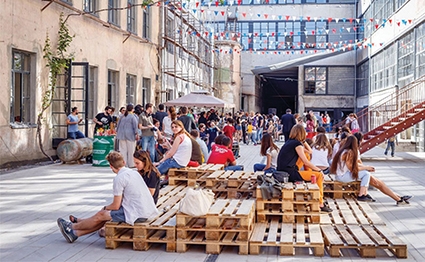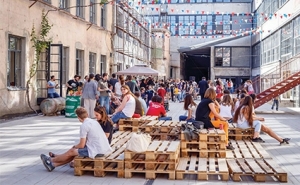Choice, Sustainability and Impact in a Modern City
The city as an entity constitutes the most productive economic, cultural and social environment in a globalized society, playing an essential role in human development. By 2050, according to a UN study, two thirds of the global population are estimated to live in urban areas. This rapid urbanization, however, comes at a cost: the trends of urban sprawl have serious implications on the city commons. These often prove to be unsustainable, omitting the most vulnerable groups and distorting the urban social fabric. GEORGIA TODAY delves deeper into the nexus between the citizens, the institutions and the business community in an attempt to understand what could constitute an inclusive city in Tbilisi and beyond.
Tbilisi’s Agmashenebeli Avenue and its vicinity has recently become a playground for the capital’s young, ambitious and trendy. From a techno club sheltered in the basement of Dinamo Stadium, to sophisticated restaurants offering Korean delicacies, the once-forgotten part of Tbilisi finds itself amid a full-fledged urban revival. Georgia’s capital is fast embracing global urban trends, including the controversial process of gentrification, when more affluent residents move to deteriorated neighborhoods. This transformation of urban space proved to be both a blessing and a curse in other metropolitan areas like New York and Berlin. While the implantation of new businesses and artistic communities conditions for a more vibrant, attractive and safe environment in these neighborhoods, vulnerable social groups inhabiting the affected areas tend to be pushed out due to inflated real estate prices and loss of affordable housing.
Fabrika, a multifunctional space targeting aspiring artists and entrepreneurs, is an interesting case in point. Based in an abandoned Soviet sewing factory, it seeks to become a venue for exchange of ideas and socialization among creative minds from Georgia and abroad. In addition to a 400-bed hostel, several bars, cafés, art studios and exhibition halls, this urban community also houses Impact Hub Tbilisi, part of an international network of innovation labs, business incubators and social enterprise community centers. The people behind this community are all young Georgian professionals, taking pride in their Tbilisian upbringing, diverse education and impressive experience. Inaugurated just earlier this month, Impact Hub Tbilisi dedicated one of its first panels to discussing the challenges, the responses and the success stories of inclusive cities.
Curiously, the pathways of gentrification in Tbilisi were not always driven by communal innovation and individual ambition, as observed in other urban metropolises. In a bid to transform the Georgian capital into a ‘European city’ following the 2003 Rose Revolution, the government endorsed ‘policy-driven gentrification’, which was particularly manifested in Tbilisi’s Old Town. In 2009, the Municipality of Tbilisi launched a scheme titled “New Life for Old Tbilisi.” The policy emerged as a response to the 2008 housing bubble burst that left USD 700-million-worth real estate development projects in suburban Tbilisi unfinished. With a view to tackling this issue, the municipality suggested subsidizing the completion of the residential blocks and offering them to the inhabitants of the Old Town in exchange for land in the historic quarters. In turn, the vacant properties were due to be put on tender for property developers, which allowed them to use the profits to pay off toxic debts and revitalize Tbilisi’s crumbling real estate market.
While the scheme was hailed for creating new jobs and providing better housing for poor families in the Old Town, critics were quick to point out the aggressive pace at which the policy was implemented with little regard to authenticity, heritage, and the social fabric. Swaths of the Old Town were subject to a “Disneyfication” as historic buildings were demolished and replaced with cost-effective replicas. Nato Tsintsabadze, the Secretary General of the Georgian National Committee of International Council on Monuments and Sites (ICOMOS), observes that such ventures are symptomatic of “the post-Soviet nihilism towards the local communities,” as institutions end up being unaccountable for their actions. Since 2000, ICOMOS is involved in a multidimensional revitalization project of the Beltemi quarter of the Old Town, which aims to mobilize the local community in the context of heritage conservation. As opposed to “New Life for Old Tbilisi,” the initiative is oriented towards creating collective awareness and expertise of local house owner associations, particularly with respect to traditional building techniques and fundraising strategies to finance restorations. Alas, the initiative is considerably limited by the neglect of institutions, emblematic of the absence of a sustainable urban strategy framework in Tbilisi.
Ukraine’s Ivano-Frankivsk is fast emerging as a success story in the context of urban development strategies in the post-Soviet space. The potential of this small Ukrainian city was energized by a platform Teple Misto (Ukrainian for ‘Warm City’), which brings together citizens, businesses and the local municipality to take part in the urban transformation processes. The platform aims to debunk the stereotype of ‘a city for tourists’ and instead adapt a ‘city for residents’ approach. According to Yuri Fylyuk, the CEO of Teple Misto, 80 percent of the funds garnered through financial contributions of investors are distributed along numerous urban development and social impact projects, ranging from the visual rebranding of the city to urban education initiatives. Administrative cost-efficiency and transparency are described as key values of Teple Misto, a distant reality for many other urban development schemes in the post-socialist countries. What makes the initiative unique is the rare organic consensus between the private and the public sectors, which, as evidenced by the recent success of Teple Misto, could condition for a productive ground for inclusive and sustainable urban development. Fylyuk, inspired by the success of the platform in Ivano-Frankivsk, hopes to expand the initiative to Ukraine’s capital Kyiv, a metropolis of almost 3 million inhabitants.
Modern cities prove to be attractive and productive not merely because of world-class infrastructure, but also because of the diversity of choice, either cultural, professional or economic. A successful, sustainable city is not defined by its skyscraper-packed skyline, but by the ease of pursuing an individual impact that opens rather than closes the doors of opportunity for fellow citizens. Thus, to condition for a more inclusive concept of urban development, it is necessary to balance out the often diverging interests of different stakeholders, namely the local communities, businesses and institutions.
Zygimantas Kapocius











